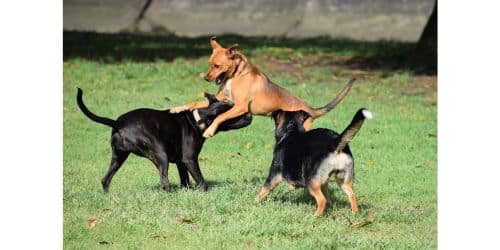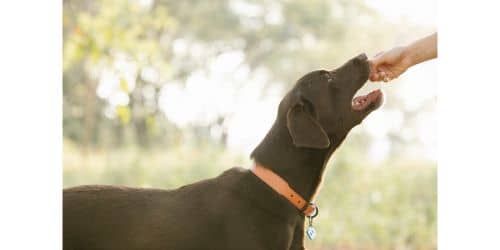Discussions and arguments over sexual orientation are prevalent across the diverse spectrum of human sexuality. However, the subject of whether dogs can be gay is frequently raised, arousing curiosity and providing interesting points for further investigation. In this blog post, we will go into the topic of canine sexual orientation, throwing light on scientific understanding, anecdotal evidence, and the nuances surrounding this fascinating subject.
Understanding Canine Sexual Behavior
Mating and reproduction, as well as social interactions, are all examples of canine sexual activity. Dogs, like many other animals, exhibit a wide range of activities connected with mating and courtship. Instinct, hormonal considerations, and social dynamics within their pack or human family all affect these behaviors.
Defining Sexual Orientation
To fully grasp the concept of sexual orientation in dogs, it is necessary to define it. Sexual orientation is defined as an ongoing pattern of emotional, romantic, or sexual attraction to people of a certain sex or gender. It is critical to remember that sexual orientation is a human construct, and extending it to non-human animals might be difficult.
The Science of Canine Sexual Orientation
Understanding the sexual orientation of non-human animals, especially dogs, is a difficult scientific subject to investigate. The concept of sexual orientation is a human construct with deep psychological and emotional components. Direct application of this notion to animals necessitates careful interpretation and consideration of their distinct behaviors and motivations.
Canine sexual orientation scientific research is limited, owing to the inherent limitations in studying and understanding animal behavior. While studies have looked into numerous elements of canine behavior, there is no solid evidence that dogs have distinct sexual orientations.
The difficulty of defining and assessing sexual orientation in non-human animals is one reason for the scarcity of study in this area. Unlike humans, who can self-identify and convey their sexual preferences, animals are unable to express their feelings. This makes determining whether individual behaviors reflect a persistent pattern of sexual attraction difficult or whether they are impacted by other factors such as social dynamics or instinctive drives.
Furthermore, examining sexual behavior in animals necessitates close observation and interpretation. Multiple elements must be considered by researchers, including the setting in which the behavior happens, the reason behind it, and the potential influence of hormonal factors. All of these factors make drawing definitive conclusions about the presence or lack of sexual orientation in dogs difficult.
Can Dogs Be Gay?
The question of whether dogs can be gay has piqued the interest and debate of dog owners and researchers alike. While dogs exhibit a variety of social and sexual activities, it is crucial to remember that extending human conceptions of sexual orientation to animals can be difficult and may not fully represent the complexities of their experiences.
Sexual activity in the animal kingdom, including dogs, serves a variety of functions other than reproduction. Dogs may mount, hump, or engage in other sexual acts to assert dominance, demonstrate social hierarchy, or even as a type of play. These behaviors are not always indicative of sexual attraction or orientation in the human sense.
Instinct, hormonal factors, and social dynamics within their pack or social group frequently have an impact on an animal’s sexual behavior. Same-sex actions in dogs might occur as a result of social bonding, establishing dominance, or just indulging in play. These behaviors should be evaluated in light of their general social interactions rather than just as signs of sexual orientation.
There has been little scientific research on canine sexual orientation, and there is no solid evidence that dogs have unique sexual orientations. The majority of existing research focuses on reproductive behaviors rather than the concept of sexual orientation. As a result, making precise claims on whether dogs can be gay or not is difficult.
While some dog owners may witness behaviors that they interpret as indicating same-sex attraction, such observations must be approached with care. Human perceptions and prejudices can influence how we see and classify animal behavior. It is critical to remember that animals perceive and express emotions differently than humans and that applying human notions directly to them is not always acceptable.
What ultimately counts is that we provide our dogs with a loving, supportive environment in which they can grow and build meaningful bonds with both humans and other animals. Rather than categorizing their sexual orientation, it is vital to accept and respect their individuality to ensure their well-being and pleasure.
Same-Sex Behavior in Dogs: Can Dogs Be Gay?
Same-sex behavior in dogs is not unusual, and it may raise concerns about their sexual orientation. When analyzing these actions, it is vital to distinguish between social bonding and sexual attraction.
Dogs, as sociable creatures, interact with both males and females in a variety of ways. Playing, grooming, hugging, and exhibiting affection are all examples of interactions. Dogs frequently engage in same-sex behavior out of a desire to form social bonds, friendships, and hierarchical relationships within their pack or social group.
For example, two male dogs engaging in mounting or humping behaviors may not necessarily indicate sexual attraction. It is more likely a display of dominance or a way of establishing social hierarchy. Similarly, two female dogs engaging in close physical contact or grooming each other are likely expressing social bonding and not sexual attraction.
It is vital to remember that dogs do not share the same societal conventions and expectations as humans about gender and sexuality. Their main driving forces are instinct, social dynamics, and a desire for company. Labeling these activities with human sexual orientation conceptions can lead to misunderstandings and misinterpretations.
While same-sex behaviors in dogs are rather prevalent, it is important to note that they do not always reflect a permanent sexual orientation. Dogs, driven by the need for companionship and social engagement, are capable of building profound emotional ties with individuals of both the same and opposite sexes.
Furthermore, the occurrence of same-sex activities in dogs does not indicate any moral judgments or consequences. Dogs, like other animals, participate in species-specific activities.
Can Dogs Be Gay: Environmental Factors and Behavior
The environment in which a dog is raised and socialized can have a big impact on their behavior, including social interactions and potential same-sex activities. Canines who are exposed to a variety of social environments, including other canines and humans, may demonstrate a greater range of social behaviors, including same-sex encounters. However, it is critical to recognize that these behaviors are motivated mostly by social bonding, friendship, and a desire for comfort rather than sexual attraction.
Dogs are highly adaptable animals that can form connections and bonds with individuals of various species, including humans and other dogs. Their socialization experiences early in infancy and throughout their growth can impact their future behaviors and interactions. Dogs raised in households or environments with a diverse range of social interactions may be more likely to engage in same-sex behaviors due to the exposure and opportunities for bonding with individuals of the same sex.
Additionally, the dynamics of a dog’s social group or pack can affect their same-sex behaviors. Dogs are pack animals by nature, and this urge to establish and uphold social hierarchies frequently drives their behavior. Dogs can use same-sex encounters, such as mounting or humping, to exert dominance or secure their place in the pack.
Regardless of their sexual activities or social relationships, it is critical to provide a supportive and inclusive atmosphere for dogs. Giving children opportunities for socialization, exposing them to different people and experiences, and creating a safe and good environment can all contribute to their general well-being and lessen the probability of behavioral issues.
Can Dogs Be Gay: The Role of Hormones
Hormones have a considerable impact on the behavior of animals, including dogs. Hormonal considerations can have an impact on many elements of a dog’s behavior, including social interactions and sexual activity. While hormones can influence certain behaviors, it is crucial to remember that they do not indicate a dog’s sexual orientation.
The hormone testosterone is linked to sexual activity and the development of secondary sexual traits in both male and female canines. Testosterone levels can affect mounting and humping behaviors, as well as dominance and territorial displays. These actions, however, are not always indicative of sexual attraction or orientation but rather of hormonal impacts and social dynamics.
Furthermore, the hormone oxytocin, also known as the “bonding hormone,” plays a function in social bonding and attachment. Positive social interactions, such as grooming, snuggling, and close physical touch, cause the release of oxytocin. This hormone helps dogs build emotional attachments and is involved in same-sex interactions as they seek friendship and social connection.
When considering a dog’s behavior, it is crucial to remember that hormonal variables are only one piece of the puzzle. Environmental influences, socialization experiences, and individual temperament are all important considerations. Because of the complexities of canine and other animal behavior, it is difficult to trace certain behaviors to hormones or any other single element.
Furthermore, while discussing hormones and behavior in animals, it is critical to avoid making direct analogies to human sexual orientation experiences. When it comes to sexual orientation, dogs do not have the same cognitive capacity or societal frameworks as humans. Their main driving forces are instinct, social dynamics, and a desire for company.
Anecdotal Evidence and Personal Accounts: Can Dogs Be Gay?
While scientific data on canine sexual orientation is lacking, there are numerous anecdotal tales of same-sex attraction in dogs from dog owners and specialists. These stories frequently include canines demonstrating love and bonding behaviors with people of the same sex. However, such experiences must be interpreted with caution because they may be impacted by human biases and interpretations.
Can Dogs Be Gay: The Complexity of Canine Emotions
Understanding dogs’ emotional lives is a continuing field of study. Dogs are well-known for their ability to create strong emotional relationships with both people and other animals. At times, the intensity of these emotional connections may be seen as a sign of sexual orientation. More research is needed, however, to understand the intricacies of canine emotions and their relationship to sexual behavior.
Can Dogs Be Gay: Ethical Considerations and Animal Welfare
When discussing canine sexual orientation, it is critical to consider the ethical implications as well as how the information could affect animal care. Applying human sexual orientation notions to animals might lead to misunderstandings and sometimes dangerous assumptions. It is critical to emphasize our canine friends’ well-being and focus on providing them with a safe, caring, and welcoming environment.
What is homosexuality in dogs?
Same-sex sexual habits and social interactions in dogs are referred to as homosexuality. It entails canines engaging in sexual behaviors or forming social bonds with people of the same sex. It is crucial to emphasize, however, that using the term “homosexuality” to describe dogs might be deceptive because it implies a human-like sexual orientation and emotional experience.
Mounting, humping, genital licking, or intimate physical contact such as cuddling or grooming with members of the same sex are examples of same-sex behaviors in dogs. These behaviors can occur for a variety of reasons, such as social bonding, establishing dominance, playfulness, or even in reaction to hormonal factors. It is critical to understand these behaviors in the context of the dog’s general social interactions, rather than only as markers of sexual orientation.
How do we know if a dog is gay?
Determining a dog’s sexual orientation can be difficult because we cannot directly converse with them about their preferences or experiences. Dogs cannot communicate their sexual orientation in the same manner that people do. As a result, determining whether a dog is gay or not is impossible.
Some dog owners and researchers may see same-sex behaviors in their dogs and interpret them as signs of a potential same-sex attraction or preference. However, such observations should be approached with caution, and alternate explanations for these actions considered.
Is it possible to train a dog to be gay?
No, it is not feasible to train or alter a dog’s sexual orientation. Sexual orientation is not a teachable or learnable behavior. It is a complicated part of an individual’s identity that is thought to be influenced by both biological and environmental factors.
Conclusion: Can Dogs Be Gay
The question of whether dogs can be gay is still a complex and intriguing one. While scientific study on canine sexual orientation is scarce, anecdotal data and observations from dog owners suggest that canines can exhibit same-sex behaviors and emotional relationships.
However, it is critical to approach this topic with carefully, as extending human conceptions of sexual orientation to animals necessitates cautious interpretation. What ultimately counts is that we provide our dogs with a safe, caring environment in which they may thrive and make meaningful connections with both humans and other animals.
We may celebrate the diversity of our canine partners’ actions, affectionate emotions, and social relationships by knowing and valuing their individuality. Let us continue to respect and care for our canine companions, appreciating their distinct personalities and the love they bring into our lives.
Related Articles
- Soft Tissue Sarcoma In Dogs: Symptoms and Treatment
- HOW DO CATS MATE? Breeding and Reproduction of Cats
- Dogs With Down Syndrome: Causes, Symptoms, and Care
- When Do Puppies Open Their Eyes and Ears For The First Time
- Can Dogs Take Claritin For Allergies?






